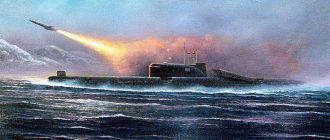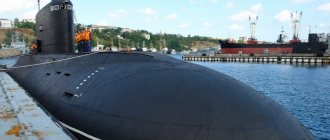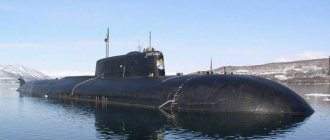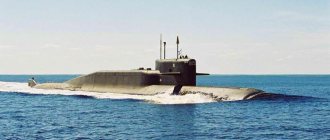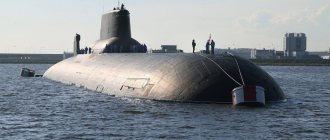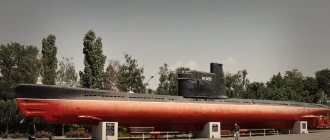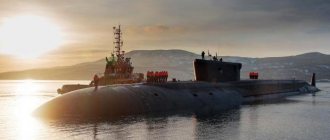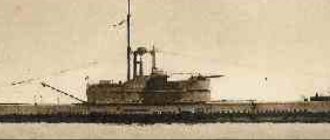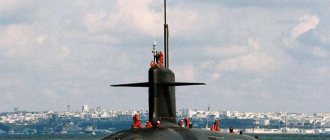Project 677 submarines (code "Lada") are a series of Russian diesel-electric submarines developed at the end of the 20th century at the Rubin Central Design Bureau. They are intended to carry out reconnaissance and sabotage activities against enemy surface ships and submarines, protect coastal areas from enemy landings, as well as lay minefields and other similar tasks.
Project 677 Lada submarines – video
Thus, the Lada submarine is optimally suited for the tasks of modern warfare, which requires maximum mobility and stealth. A special feature of the submarines of this series is their construction scheme, called “one-and-a-half”. The fact is that the body (made of AB-2 steel) has the same diameter along its entire length. Unlike large nuclear boats, the bow and stern have a well-defined spherical shape. Thanks to the bulkheads, the hull is divided into five independent compartments. There are three decks on the ship.
Impressive hydrodynamic characteristics are achieved thanks to a specially designed hull with a particularly well-streamlined shape. The retractable devices have exactly the same barrier that characterizes Project 877 ships, but the stern empennage is made cross-shaped, and the front rudders are mounted on the fence. This was done so that they create as little interference as possible during the operation of the sonar equipment equipped with the submarine. The Lada project is a real standard in this sense: it is extremely quiet, it is extremely difficult to detect by sonar and hydroacoustics.
Design Features
One of the main differences between Project 677 and the Halibut and Varshavyanka submarines was the one-and-a-half-hull design. At the same time, the lightweight body is so small that sometimes the Lada is called a single-hull Lada. This decision led to a reduction in the size of the submarine and its displacement. At the same time, it was possible to further reduce the noise level created when the submarine moves, and it became much more difficult to detect.
Housing and its layout
The durable hull of Project 677 submarines is made of special AB-2 steel. Its shape is close to cylindrical, and its diameter remains almost unchanged along its entire length. There are hemispherical ends at the bow and stern. The front depth rudders are installed on the wheelhouse, and the rear ones are installed on the stern, forming a kind of “cross” together with the steering wheel. In general, the control surfaces are placed in such a way as not to interfere with the operation of the hydroacoustic complex.
The building is divided into separate rooms by transverse bulkheads and longitudinal platforms.
Layout diagram of the Project 677 submarine
The list of compartments is as follows:
- Bow (torpedo compartment). It contains torpedo tubes, spare ammunition and a silent reloading system;
- Second compartment. The main room is the central post from which the submarine is controlled. On the lower tiers there are some batteries and auxiliary mechanisms;
- Third (living) compartment. There is a wardroom, a galley, a medical unit, as well as cabins for all crew members;
- Fourth compartment. Designed to accommodate diesel generators;
- Fifth compartment. There is an electric motor here that drives the submarine's propellers.
Thanks to a fairly large wardroom and the availability of sleeping places for each of the crew members, Project 677 Lada submarines became the most comfortable of all built for the Soviet and Russian navies.
An anti-hydroacoustic coating is installed on the submarine’s hull, the layer of which reaches forty millimeters in thickness. Thanks to this, its own noise is reduced and signals from enemy active hydroacoustic stations are absorbed.
Power point
The submarine is driven by the main electric propeller engine SED-1. Its power is 4100 horsepower. Rechargeable batteries (in a submerged position) or 28DG generators, generating direct current with a total power of 2000 kilowatts and connected to D-49 diesel engines (V-shaped engines with eight cylinders), can be used as a current source.
Appearance of the D-49 diesel engine
In addition, there are two PG-102M auxiliary electric motors on board. Each of them develops 140 horsepower. These motors are intended for screw remote columns, with the help of which steering is carried out.
Unfortunately, the air-independent power plant is not currently used on Project 677 submarines. Its parameters are unknown, although previously representatives of the Rubin Design Bureau claimed that the anaerobic engine they created would allow the submerged submarine to move at speeds of up to 10 knots.
Target equipment
The main tool for searching for targets on Project 677 submarines is the Lyra sonar system. It includes the following elements:
- Noise direction finding antennas. The main one, L-01, is located on the bow of the submarine. The other two are also located in front of the boat, but on the sides;
- Hydroacoustic station with towed antenna;
- Active sonar for communication under water, measuring distances and searching for mines.
Data processing is carried out by the Lithium combat information and control system. When on the surface, the KRM-66 radar system can be used.
Armament of the Project 677 Lada submarine
The main means of defense and attack are six devices for launching 533 mm torpedoes, with two shafts on the upper deck designed for firing guided ammunition. The standard ammunition includes 18 torpedoes. Most often, the Lada 677 submarine uses universal-type ammunition (SAET-60M, UGST) and special torpedoes to destroy enemy submarines. On board there may be cruise missiles, as well as 22 mines of the DM-1 model.
There is the possibility of combat use of anti-submarine missiles of the Shkval type. The firing system allows both single shots and salvo firing from six mines simultaneously. The Murena complex is responsible for reloading the torpedo tubes, which allows the entire operation to be carried out in a fully automatic mode. The entire process is fully controlled from the command and control post equipped with the submarine. The Lada project was the first development in the Soviet Union of a non-nuclear submarine that would use such a number of complex and highly efficient automation.
To ensure the protection of the boat from enemy combat aircraft, the crew can use six MANPADS of the Igla-1M model. Coordination of the work of all combat systems is ensured through the use of the Lithium system. Thus, the Lada submarine, the armament of which we have described, despite its small dimensions, can cause big problems to any enemy.
History of creation
A little over thirty years ago, in 1988, a submarine was introduced into the Swedish Navy, equipped, along with traditional diesel engines, with a special auxiliary engine. This was the so-called anaerobic power plant. Its main difference is the ability to work without the use of atmospheric air. This feature allows submarines that do not have a nuclear reactor on board to spend up to twenty days underwater, which radically increases stealth.
In the USSR, submarines with power plants of this type, “Stirling engines,” were created back in the 50s of the last century, but their practical use turned out to be extremely dangerous due to technical difficulties associated with the need to store liquid oxygen on board. However, after the appearance of new Swedish submarines, it became clear that the old idea needed to be thought through at a new level.
Non-nuclear German submarine type 212A with an air-independent power plant
In subsequent years, the presence of an air-independent power plant (VNEU) became a key feature of fourth-generation non-nuclear submarines. Meanwhile, submarines with conventional diesel generators and electric motors continued to be in service with the Soviet and then Russian fleets.
In order to eliminate the emerging backlog, it was decided to create a domestic VNEU. It was planned to install it on large submarines of Project 677 (code “Lada”), the development of which began in 1987. At the same time, the Soviet anaerobic power plant was not supposed to become a Stirling engine - it was about creating a so-called electrochemical generator (ECG). Subsequently, German submarine designers followed this path, eventually creating quite successful Project 212A fourth-generation non-nuclear submarines at the end of the twentieth century.
Previously, the USSR had already produced ECGs for spacecraft, so there was every reason to expect success. The level of optimism was so high that the development of Project 677 non-nuclear submarines began even before the creation of VNEU. This turned out to be a wrong decision.
The first blow came in 1991, when the Soviet Union collapsed. A sharp reduction in all funding programs led to the real degradation of the 677 project and the almost complete curtailment of work on the creation of an anaerobic engine. True, the first ship of the new series, called “St. Petersburg,” was laid down in 1997, but its subsequent construction was significantly delayed.
Lead submarine of Project 677 – “St. Petersburg”
The difficulties were largely due to the fact that the management of the Rubin design bureau, which designed the new submarine, decided to take the most ambitious path - to create a closed-cycle engine without any emissions into the external environment and at the same time not to store on board the necessary for the electrochemical reaction hydrogen, and produce it directly from diesel fuel. The corresponding process is called reforming.
The boat “St. Petersburg” was launched back in 2004. It was equipped with conventional diesel generators with the prospect of further re-equipment at VNEU. It was assumed that in the future, Project 677 submarines would gradually displace the Halibuts and Varshavyankas, the third generation submarines of Projects 877 and 636, from the fleet.
took place from 2009 to 2010, after which the ship was transferred for trial operation to the Russian Navy without being put into service. It immediately turned out that the practical use of this submarine was out of the question. In particular, the power plant could safely operate at only 50% of the power stated in the documentation. For a short time, the thrust could be increased to 70% of the nominal value, but this often caused breakdowns of a number of parts, which then required lengthy repairs. In addition, the characteristics of the submarine’s combat information and control system and its sonar system turned out to be unsatisfactory.
"St. Petersburg" during testing in the Navy
Commenting on the results obtained, Commander-in-Chief of the Russian Navy Vysotsky categorically stated that the fleet does not need such submarines. However, he then explained that the Lada project itself remains promising - only the St. Petersburg will remain a prototype for testing technologies.
Subsequently, after the change of command of the Navy, funding for the Project 677 submarine program was resumed. In 2013, in particular, construction of the second submarine of this series, called Kronstadt, was resumed.
Meanwhile, the developers of the anaerobic power plant continued to be plagued by failures. Representatives of the Rubin Central Design Bureau, over the years, gave rather contradictory comments about the progress of their project, either promising to demonstrate a finished engine of the required power in the very near future, or complaining about the complete cessation of funding.
The situation with VNEU remains uncertain today. Apparently, the 677 series submarines will never receive this fundamentally new power plant. In any case, the already launched Kronstadt does not have it, nor will it appear on the Velikiye Luki submarine under construction. In accordance with the stated plans of the Rubin Design Bureau, the submarines of the Kalina project will be equipped with air-independent engines, but if this happens, it will be in a rather distant future.
We have to admit that the program to create Project 677 submarines was clearly unsuccessful. In their current form, the St. Petersburg, the Kronstadt, and the Velikiye Luki are not fourth-generation, but third-generation submarines that have no tangible advantages over the old Varshavyanka.
Model of an anaerobic energy module for submarines of the Kalina project
The lag behind foreign designers was so obvious back in the 2000s that the question arose about purchasing German Project 212A submarines for the needs of the Navy.
Today there are no such plans, but the situation remains uncertain. If the development of VNEU is not completed in the near future, Russian creators of non-nuclear submarines risk falling behind their foreign competitors not for a few years, but forever.
Hydrolocation complex
The Lyra complex, which includes powerful sensitive antennas, is responsible for sonar reconnaissance. The installation includes three antennas, one of which is located on the bow of the submarine, and two are mounted on its sides. Engineers maximized their diameter to accurately measure underwater noise. Thus, the front antenna occupies almost the entire space on the bow of the submarine. In case of damage to the on-board equipment, there is manufactured sonar equipment, which the Lada submarine (project 677) can tow along with it on the march.
Combat and training use
Until now, the fleet included only one Project 677 submarine, the St. Petersburg. Its use was exclusively experimental - various on-board systems and equipment were tested. At the same time, a huge number of various shortcomings were discovered. Suffice it to say that after the submarine was handed over to the customer, it turned out that there was no sonar system on board - only external antennas were installed.
The seaworthiness of the ship, due to a poorly functioning power plant, did not allow leaving the port in stormy conditions and significant waves. Many other components and assemblies also caused criticism. Over the following years, most of the detected defects were eliminated, but even today the reputation of St. Petersburg is not brilliant.
In April, this submarine test-launched a cruise missile - for some reason, directly from the base. Despite the successful defeat of the target, the condition of the submarine and the degree of its combat readiness are still in question.
The submarine "Kronstadt" before participating in the naval parade in St. Petersburg
The next ship in this series, Kronstadt, has been launched and is undergoing a test cycle. In July 2022, this submarine took part in the naval parade in St. Petersburg.
Navigation system
The navigation system is of inertial type. Responsible for providing data on the exact location of the ship, as well as for determining the optimal speed at which the weapons on board can be used with maximum efficiency.
The system includes periscope equipment of the Parus-98 type, which includes the following elements:
- Non-penetrating commander's periscope, "Parus-98KP". It has daytime and low-level channels (optical and TV). The degree of magnification varies from 1.5 to 12X, it is possible to video record the observed data.
- Optocoupler mast, non-penetrating type "Parus-98UP". In fact, it is a multifunctional universal periscope. The design includes two channels (day and low-level), the magnification level is the same as that of a command telescope, and there is a highly efficient laser rangefinder.
Thus, the Lada submarine, the performance characteristics of which we have briefly described, can be used with equal success in day and night conditions. She always remains invisible to the enemy.
Other elements of the navigation system
The most important element is the radar system of the KRM-66 Kodak radar model. Includes active and passive radio channels and can operate in combined mode. When actively used, a particularly protected, hidden communication channel can be activated. It gives a complete picture of the situation surrounding the submarine (including the surface), but does not in any way unmask the ship. In this sense, the Lada submarine (Project 677) is in many ways a unique object, which really has no analogues in the world, no matter how hackneyed this expression may sound.
Digital communication system of the “Distance” model. Allows you to exchange information via a bidirectional secure information transmission channel with coastal command posts, ships and aircraft (provided you are at periscope depth). If there is a need to send an urgent message from great depths, a towed release antenna is used. This equipment is housed in a particularly robust casing that can protect it even in the event of hostilities. Simply put, the Lada is a very durable boat.
Finally, the Appassionata navigation equipment complex. Contains an inertial navigation system, as well as a GPS/GLONASS satellite navigation module. The accuracy of location determination when using it is extremely high, but depends on the proximity of the base station for the correction for a particular “provider”.
“Made with us” and on Yandex.Zen
The fourth generation of non-nuclear submarines of Project 677 Lada has surpassed in its characteristics the Project 636 submarines, which are unofficially called a “black hole” for their stealth and noiselessness.
This was stated in a conversation with a TASS correspondent by the General Director of Admiralty Shipyards JSC Alexander Buzakov. “Based on the results of the trial operation of the St. Petersburg submarine, we can say that the Lada is superior in stealth to its predecessor Project 636, which is called a “black hole” all over the world,” he said.
The fourth generation submarines of the Lada project are a further development of the 636 project submarines, Buzakov recalled. They are distinguished by a low noise level thanks to a new anti-hydrolocation coating, an improved sonar system, as well as new technologies and materials.
“In addition, as part of the implementation of Project 677, a significant amount of research and development work (R&D) was carried out. By introducing new developments on Project 677 submarines, we are “pushing” Project 636 submarines to a new level. A good example is non-penetrating lifting-mast devices, which were first installed on the first Lada (St. Petersburg), and today have been successfully implemented on all series 636 of the project,” added the agency’s interlocutor.
The head of the Admiralty Shipyards noted that today boats of projects 636 and 677 are “one of the most serious representatives of their class due to powerful missile weapons.”
Speaking about the possible continuation of the Lada series, Buzakov emphasized that such issues are within the competence of the Ministry of Defense. “Yes, there are such plans, but without a government resolution on the state defense order, it is premature to talk about specific terms for signing the contract,” the agency’s interlocutor explained.
Admiralty Shipyards is one of the oldest shipbuilding enterprises in the country. In 2014 they celebrated 310 years since their founding. Almost 3 thousand vessels for various purposes left the plant’s slipways, including the world’s first seaworthy destroyer, the so-called “hidden ship” - the prototype of the first submarine, the legendary cruiser “Aurora”, the first nuclear-powered icebreaker “Lenin”.
Today this St. Petersburg enterprise is the center of non-nuclear submarine shipbuilding in Russia. Submarines of projects 636 and 677 are being built on the stocks of the Admiralty Shipyards.
Well, then I bring to your attention detailed information about these submarines. Taken from here -:
Large diesel-electric submarine ("B"). Developed by Central Design Bureau MT "Rubin", chief designer - Yu.N. Kormilitsyn. R&D began in 1987 and initially it was planned to build a large series of submarines at the Leningrad Admiralty Association (Leningrad), Sevmash (Severodvinsk), Krasnoye Sormovo (Nizhny Novgorod) and Im. Lenin Komsomol" (Komsomolsk-on-Amur).
The technical design of the submarine pr. 677 was approved in 1993, but was sent for processing. The second version of the technical design was approved in 1997. During the creation of the submarine, 180 design and development projects were worked out. The development of the GAK at the initial stage was entrusted to the Okeanpribor Research Institute, but the project of the GAK proposed by them due to the weight and size characteristics could not be placed on the submarine pr. 677. General Director of the Central Design Bureau for MT "Rubin" I.D. Spassky achieved the decision of the Ministry of Ship Industry to transfer the development of the GAK radio electronic software "Volna" (Moscow). In the summer of 2005, FSUE NPO Elektropribor (St. Petersburg, contract dated April 2006) joined the development of the SAC as the main contractor.
The lead boats of the series - Project 677 "Lada" - B-585 (sometimes the names B-100 and S-100 are found, serial number 01570) and the lead boat Project 677E "Amur" ("Amur-1650") were laid down at the FSUE plant " Admiralty Shipyards" (St. Petersburg) December 26, 1997. In 1997, the submarine B-585 received the name "St. Petersburg". During 1998-2001 (as of April 1, 2002), Admiralty Shipyards spent 335.1 million rubles on the construction of the lead submarine pr. 677, including 263.1 million rubles from the federal budget (including 175.5 million rubles in 2001). In the first quarter of 2002, there was no federal funding for the construction of the order ().
The lead boat was launched on October 28, 2004. The submarine was planned to be delivered to the Navy in 2006 (it did not take place on time). On December 14-21, 2005, the submarine “St. Petersburg” made its first trip to sea for testing, and its first dive was completed. According to media reports, in 2006 the boat was supposed to begin state tests, but until the first half of 2008 (at least) it underwent factory sea trials with fine-tuning of submarine components and complexes. As of 2009, the acceptance of the boat by the Navy is planned for 2009-2010. In February 2010, it was announced that the lead boat “St. Petersburg” would be accepted into trial operation by the Navy before the summer and on April 22, 2010, the Navy signed an acceptance certificate of the lead boat B-585 “St. Petersburg”, the boat was accepted for trial operation. On May 8, 2010, the flag of the Russian Navy was raised on the submarine B-585 “St. Petersburg”.
Submarine B-585 "St. Petersburg" pr. 677 on the Neva in St. Petersburg on Navy Day, 07.25.2010 (photo - Dmitry Shipulya,). The series of submarines pr. 677 is in production - only according to plans for 2009. It is planned to build 8 submarines of this type for the domestic Navy. According to the State Armament Program for 2007-2015, the construction of 6 submarines of Project 677 is planned. In early November 2011, information appeared that the construction of the submarine of Project 677 was frozen. On November 24, 2011, General Director of the Rubin Central Design Bureau MT A. Dyachkov stated that the project boats will be modernized according to a revised technical design (code name pr.677D). The new technical design will be ready in 2013, after which the second and third boats of Project 677 will be completed according to the new design.
On June 27, 2012, information appeared in the media that the Russian Navy had decided to resume construction of the submarine pr. 677 according to an adjusted project. On 02/13/2012, General Director of Rosoboronexport OJSC Anatoly Isaikin told the media: “To date, the decision on the serial construction of these submarines has been made by the Russian Ministry of Defense. Funding for construction is planned in the state defense order, and trial operation of the submarines is taking place in accordance with the program, which is being successfully implemented.” On May 18, 2013, the Commander-in-Chief of the Navy announced in the media that the Navy will receive the first three submarines of Project 677 with conventional power plants ( ). The contract for the construction of Krognstadt and Sevastopol came into force on July 9, 2013 ( ).
Submarine "St. Petersburg" pr. 677 during testing. Baltic, no later than the summer of 2007 (photo from the Curious archive, .
Submarine B-585 “St. Petersburg” pr. 677 in Kronstadt, November 2010 (photo from the archive of Vladimir Vladimirovich,).
One of the first images of the preliminary design model of the Amur family submarine (export version - Amur-1650) in the media (approximately 1997)
The design of the submarine is one-and-a-half-hull; the hull structure uses AB-2 steel developed by the Central Scientific Research Institute of KM “Prometheus”. Due to the use of the most modern means of acoustic protection, it is assumed that the noise level of the submarine will be several times lower than the noise level of the submarine. The submarines of this project are equipped with horizontal deckhouse rudders. The anti-hydroacoustic coating of the boat was developed by the Central Research Institute named after. Academician Krylov is made of 7-8 layers and a thickness of 40 mm.
1 compartment - GAK and TA antennas 2 compartment - command post 3 compartment - residential 4 and 5 compartments - power plant
The bow block module of the hull of the submarine "Kronstadt" before transportation from workshop No. 9 to workshop No. 12 of the FSUE "Admiralty Shipyards", December 2014 ("Admiralteets", No. 23 / 2014).
Submarine "St. Petersburg" pr. 677 LADA (October 28, 2004, )
Launching of the submarine "St. Petersburg" pr. 677 (October 28, 2004, )
The quality and condition of the anti-hydroacoustic coating of the submarine B-585 “St. Petersburg” as of 2005 (above) and 2011 (below). Photos from the IMDS salons, St. Petersburg. (photo - adv1971, 2005 and Cheslav, 2011, and).
Details of the hull of the submarine B-585 “St. Petersburg” pr. 677 on the Neva in St. Petersburg. Removal from the launching dock, apparently after repairs, 06/01/2012 (photo - pfc-joker, ).
Engines: full electric propulsion with a single all-mode electric motor
2 x 28DG DC diesel generators from the Kolomna Plant and JSC Elektrosila with a power of 1000 kW each, the generator uses an 8-cylinder V-shaped diesel engine D-49 with a piston diameter of 260 mm, a piston stroke of 260 mm and a rotation speed of up to 1000 rpm min. Diesel generators are controlled remotely from a central control room using a digital control system. During the repairs, which until March 27, 2012, were carried out on the lead boat “St. Petersburg” at the Admiralty Shipyards, the generators were replaced (). 1 x main propulsion electric motor SED-1 (brushless low-speed all-mode electric motor with permanent magnet excitation) with a power of 4100 hp. (4100 kW according to other data), developed by the Rubin Central Design Bureau for Mechanical Engineering together with the Federal State Unitary Enterprise NIIEFA named after. D.V. Efremova. Manufactured by JSC New Era (assembly), JSC Elektrosila, Federal State Unitary Enterprise Central Research Institute Elektropribor. Control - digital control system developed by the Central Research Institute "Electropribor". A small-sized experimental prototype of the engine was successfully tested, the first full-size prototype was installed on the head submarine of Project 677. Based on the results of tests in 2006, significant modification of the system was required at a rotation speed of 125 rpm or more, carried out in 2007. Power developed by the engine during tests according to Lukin (see sources) did not exceed 50%. As of May 2010, the B-585 submarine was accepted for trial operation by the Navy with the main propulsion unit operating at 60% power. As of November 2011, according to unofficial data and according to the media, problems with the lack of development of the electric motor remain. 2 x remote screw columns RDK-35 with electric motors PG-102M (?) with a power of 140 hp each. developed by NPP “Marine Technology”.
Diesel generator 28DG (photo from the DenisKA archive,). Electric motor SED-1 on a test bench at the Rubin Central Design Bureau for MT (photo at the Rubin Central Design Bureau for MT)
On boats pr. 667D, the electric propulsion system will be modernized ().
Mechanics - 1 shaft and 1 fixed-pitch 7-blade propeller with saber-shaped blades and two remote propeller columns RDK-35.
Submarine "St. Petersburg" pr. 677 LADA (October 28, 2004, )
Launching the submarine "St. Petersburg" pr. 677 into the water (October 28, 2004, )
Photomontage based on photographs taken during the launching of the submarine “St. Petersburg” pr. 677 LADA (October 28, 2004, )
Remote screw column RDK-35, submarine B-585 “St. Petersburg”, 2009 (photo from the archive of Testers_10,).
Energy - batteries, 2 groups of 126 pieces - product 476, total power - 10580 kW/h. PL power supply system - for retractable devices - direct current with a voltage of no less than 175 and no more than 320 volts.
According to an interview with the director of the Admiralty Shipyards, Alexander Buzakov, the completion of boats according to the modernized project will begin in 2013 if they are included in the State Defense Order for a year. Also, when the standard lithium batteries are ready, they will be installed on the Kronstadt submarine. As of September 2012, funding has been allocated for work on lithium batteries, and pilot work has been carried out.
The rescue system is a universal rescue complex of the KSU-600 type for the remote automatic release of PSNL-20 life rafts (2 pieces, in the superstructure in front of the retractable devices fence, the system was developed by the Lazurit Central Design Bureau, also used on the Gepard submarine).
Performance characteristics of the submarine: Crew - 35 people
Length - 66.8 m Width - 7.1 m Draft - 6.7 m Surface displacement - 1765 tons (1950 tons according to other data) Underwater displacement - 2650 tons Surface speed - 10 kts Maximum underwater speed - 21 kts Maximum underwater cruising range with alternating RDP mode (speed 7 knots) and quiet running (3.5 knots) - 16,000 miles (including fuel consumption for charging batteries) Underwater range in RDP mode (speed 7 knots): - 6,500 miles (excluding fuel consumption for charging batteries) - 6,000 miles ( ) Underwater range (speed 3 knots) - 650 miles Operating immersion depth - 240-250 m (according to various sources) Maximum immersion depth - 300 m Autonomy - 45 days Guaranteed service life - 25 years Guaranteed service life before first repair - 10 years Submarine noise - by According to statements in the media, the noise level of Project 677 should be 50% of the noise level of the submarine Project 877, which means in calm conditions the noise level is about 30 dB. Armament: 6 x bow 533-mm torpedo tubes with an air firing system and an automatic rapid silent reloading device “Murena” (2 upper tier torpedo tubes are adapted for firing remote-controlled torpedoes). According to the specifications for the creation of the submarine, it was planned to install 4 torpedoes with an ammunition load of 12 torpedoes. Ammunition - mines, 18 torpedoes (SAET-60M, UGST and USET-80K types), Shkval torpedo missiles and Turquoise anti-ship missiles (Club-S), launched from torpedo tubes or 22 DM-1 type mines. According to 2009 data, in the 1990s, the TE-2 “Toy” torpedo was developed for the submarine Project 677 - fate unknown. 6 x MANPADS “Igla-1M”
The submarine torpedo tube system, pr. 677 (drawing by Tomasz Grotnik, from Grotnik Tomasz, Pierwsza Lada przed wejsciem do sluzby. // Nova Technika Wojskowa. No. 3 / 2007 Poland). View of the covers of the bow torpedo tubes of the submarine “St. Petersburg” pr. 677 LADA (October 28, 2004, )
View of the bow of the submarine “St. Petersburg” pr. 677 in the floating dock. St. Petersburg, April 2008 (photo from the Amoralex archive, .
The bow of the submarine "St. Petersburg" pr.677 - the hatch for loading torpedoes is clearly visible in the center ( ).
Submarine B-585 “St. Petersburg” pr. 677 on the Neva in St. Petersburg. Removal from the launching dock, apparently after repairs, 06/01/2012 (photo - pfc-joker, ).
Equipment:
| Ave. 677 | Ave. 677D | |
| BIUS (combat information and control system) | An integrated system for automated control of the ship “Lithium” developed by NPO “Aurora” with the participation of the Central Design Bureau for MT “Rubin” and several research institutes of the Navy (the prototype of the “Lithium” system is the “Bulat” system developed in the 1980s). Automated traffic control system “Liana”. As of November 2011, according to some media, there are still problems with the unfinished BIUS “Lithium” (not confirmed). | BIUS "Lithium" |
| Management of general ship systems | Modernized control system for ship equipment () | |
| GAK | GAK "Lira" (according to the results of tests in 2006, significant improvements to the system were required - probably in terms of interfacing the GAK with the BIUS "Lithium" and in terms of software) - R&D of the GAK since the early 1980s. The main developer is Volna software (Moscow), the main developer is the Elektropribor Central Research Institute (officially since April 2005, actually since the summer of 2005). GAK is produced by the Taganrog Priboi plant. As of 2008, design tests of the GAK and software tests were being carried out at the stand. Composition of the SAC: - Device No. 1 SAC "Lira" - bow quasi-conformal noise direction-finding antenna of a large area L-01 - On-board quasi-conformal noise direction-finding antennas GAS in the bow of the hull - GAS active mine detection, distance measurement and underwater sound communication - GAS with a towed acoustic antenna (ex. 677 - exactly, project 677E - ?) - Navigation safety equipment “GAS-BP” (third final stage of testing since January 2007) | SJSC "Lira" |
| Radar complex | Radar KRM-66 "Kodak", export version KRM-66E - developed and produced by the Granit-Electron concern (St. Petersburg). Includes active and passive radar channels, a combined antenna channel post, a set of spare parts. Power supply - from a DC network 175-320 volts Power consumption - 3.5 kW | |
| Radio technical equipment | ||
| Radio communication | Digital radio communications complex “Distance” (including a towed output antenna K-697 for underwater communications - from the upper aft end of the wheelhouse fence, antenna length 20 m, used at depths of up to 100 m according to unverified Western data) | |
| Navigation complex | The “Apassionata” navigation complex (tested in 2007) with an inertial navigation system and a GPS / GLONASS satellite navigation system - for the first time on nuclear submarines in the USSR and Russian Navy, small-sized, with reduced energy consumption. By 2008, it passed state tests, developed by the Elektropribor Central Research Institute. Navigation accuracy - deviation of location coordinates in 2 days - 5 km when changing courses up to 6 degrees / min. The completion of the development of the Elektropribor Central Research Institute complex was announced on December 3, 2003 (), the cost of the complex is reported to be 8 million USD. Both periscopes have gyroscopic line of sight stabilization. The operation of periscopes is ensured at submarine speeds of up to 10 knots. In 2004, the Parus-98 UPC was shipped to the Admiralty Shipyards Federal State Unitary Enterprise for installation on the head submarine pr. 677 St. Petersburg. | Upgraded navigation complex () |
| Periscopes | Unified periscope complex UPC "Parus-98" ("Parus-98E" - export version). The developer is the Central Design Bureau for MT "Rubin", the main contractor and co-developer is the Central Research Institute "Electropribor". Composition of the complex: - commander's periscope of the non-penetrating type "Parus-98KP" (commander's periscope) with optical and TV channels with variable magnification from 1.5 to 12X - daytime and low-level, with video recording - developed by the Federal State Unitary Enterprise Central Design Bureau "Foton"; - optocoupler mast of the non-penetrating type "Parus-98UP" (universal periscope) with TV channels with variable magnification from 1.5 to 12X - daytime and low-level, thermal imaging channel, laser rangefinder channel - developed by FSUE Central Design Bureau "Foton"; | UPK "Parus-98" |
| Other |
At the stage of the first sea trials (December 2005), a non-standard navigation radar “Gals” produced by NPO “Gorizont” was installed on the submarine “St. Petersburg”. On the submarine "St. Petersburg" since 2007, the following equipment has been tested: PMU (retractable deckhouse fencing devices) "Jikler", PMU "Kodak", PMU "Pineapple", RDP, UPC "Parus-98" (with outboard cables) , BDA blocks of the “Blade” complex, SEV “Gnome-2M”. R&D "Lira" (GAK) did not pass the test due to the unavailability of the software (revision plan - 2008). The submarine uses the emergency transmitter of the COSPAS-SARSAT B-603 system. On the submarine "St. Petersburg" pr. 677, as of the summer of 2009, the SAC is still being finalized. The submarine pr. 677E, as of 2007, does not yet have a sonar system (it is not ready, the amount of expenses for the development of the sonar system is already 1 billion 300 million rubles).
As of November 2011, according to unofficial data, the problems with the lack of knowledge of the SAC have been resolved.
Quasi-conforal noise direction finding antennas GAS (side and nose) SJSC "Lira" (photo from SKB MT "Rubin", Grotnik Tomasz, Pierwsza Lada przed wejsciem do sluzby. // Nova Technika Wojskowa. No. 3 / 2007 Poland).
General view and fragment of the quasi-conformal noise-direction-finding antennas of the GAS (bow and side) of the Lyra SJSC (photo probably of the Kronstadt submarine, 2009, from the Deep Blue Sea archive).
Optocoupler mast “Parus-98UP” of the unified periscope complex “Parus-98E”, exhibition IMDS-2009, St. Petersburg (photo abl22, 2009)
Laser rangefinder and TV channel module (left) and thermal imaging device module (right) for an optocoupler mast (FSUE Central Design Bureau “Foton”, 2009)
Antenna post of the radar KRM-66E of the periscope complex "Parus-98E", exhibition IMDS-2009, St. Petersburg (photo abl22, 2009)
Main command post of submarine pr. 677 (drawing by TsKB Rubin)
Devices in the fencing of the cabin of submarine pr. 677 (drawing by Tomasz Grotnik, from Grotnik Tomasz, Pierwsza Lada przed wejsciem do sluzby. // Nova Technika Wojskowa. No. 3 / 2007 Poland).
Unified periscope complex “Parus-98” and the fencing of the cabin of the submarine “St. Petersburg” pr. 677 LADA with retractable devices, December 2005 (based on photo by Oleg Karpenko, )
Power point
The “heart” of the submarine is a diesel-electric power plant, made according to a scheme that provides for movement exclusively on electric power. This is what distinguishes the Lada submarine from its foreign analogues. TTS (transport and technical systems) of foreign ships of this class can only operate on a diesel engine.
The diesel engine is located in the fourth compartment. To generate electricity, two 28DG brand generators are used, coupled with rectifiers with a power of 1000 kW each. Energy is stored in two groups of batteries. Each of them contains 126 elements (they are located in the first and third compartments). The total combined power of the entire installation in peak condition is 10580 kW/h. The working motor is electric, excited by permanent magnets. Brand SED-1, power density is 4100 kW.
The chosen engine power and battery capacity are not random. The fact is that it is precisely with this ratio that accelerated battery loading becomes possible, which almost halves the submarine’s presence at periscope depth. Since the generator does not contain a brush current collector, the maintenance and operation of the entire installation is greatly simplified and becomes much safer. In this respect, the Lada is a boat that was in many ways ahead of its time.
Advantages and disadvantages
Unfortunately, Project 677 submarines are still difficult to consider successful. Despite the fact that in publications they are called fourth-generation submarines, in fact they belong to the third. Their most significant advantages are:
- Acoustic stealth. According to the designers, they managed to achieve a reduction in noise level by 50% compared to Varshavyanka;
- Improved characteristics of the sonar system. The exact values are not stated here;
- Ability to use the most advanced weapons systems;
- Excellent conditions on board for the crew.
The main drawback of the boat is obvious - it did not receive the power plant planned in accordance with the project. Due to this, Project 677 submarines are the same “diving” ones as their predecessors; no development in this direction has occurred. In addition, there is still no detailed information about whether it was possible to achieve full operation of the hydroacoustic complex.
The salvo launch capability declared by the manufacturer has not yet been evaluated in any way. Most likely, the Amur-950 submarines should have had this characteristic, but they have not yet been built.
Construction of the Project 677 submarine “Velikie Luki”
In general, it can be assumed that the Project 677 submarines will not displace, but rather will complement the diesel submarines “Halibut” and “Varshavyanka”, already available in the Russian Navy. The reduced displacement will allow the new boats to be used primarily near the sea coast.
Basic engine operation diagram
The all-mode electric propulsion system plays the role of the main propulsion device in all traveling states of the ship. In principle, we have already said that movement on diesel power alone is not provided for in principle. The propeller has seven blades and is made using a special, low-noise technology. This state of affairs was largely achieved thanks to the saber-shaped blades, which produce a minimal noise level when moving. In addition, the submarine has two remote steering columns of the RDK-35 brand.
The maximum achievable surface speed is 21 knots. When submerged, the submarine does not accelerate beyond 10 knots. The cruising range is about 6,000 miles, but when driving economically, you can increase the resource by approximately another 650 miles.
On the living and working conditions of the ship's crew
The crew consists of 35 people. To save people in case of emergency, the KSU-600 rescue system is provided. It involves remote automatic release of life rafts of the PSNL-20 model. There are two of them in total, they are located in the add-on for retractable devices. The living area on the submarine is located in the third compartment. Unlike the surface ships of the USSR and the Russian Federation, very good living conditions have been created for the crew. Double cabins are provided for personnel. Each officer is assigned a separate room.
Meals take place in the wardroom, combined with a pantry room. Food supplies, depending on their characteristics and storage requirements, are located in refrigerated and non-refrigerated pantries. In recent years, submarines of this series have begun to be equipped with a new type of galley equipment: with a very compact size, it ensures the preparation of a complete and varied food allowance for the crew.
Fresh water supplies are stored in food grade stainless steel tanks. You can replenish your supply of fresh food water directly on the go. For this purpose, desalination plants are provided, which use heat from running diesel engines to operate. In general, during the normal course of the hike, the water reserves are quite sufficient to meet not only domestic, but also technical needs. Fully loaded with everything necessary, the submarine remains autonomous for 45 days.
What's new?
Many innovations will be introduced into the design of a well-proven ship. The developer is the famous enterprise TsKB MT "Rubin". In mid-2013, it was finally decided that the Lada submarine would continue to be in service with the Russian Navy. In a modernized version, of course. Domestic specialists paid much attention to the modernization of on-board electronic systems. The automation of the torpedo launcher was completely rethought, and the mechanics of the electric power plant were almost completely redesigned (taking into account the use of modern technologies). Navigation was not left out either: considering how many new solutions were incorporated into it, we can safely say that this system has been created anew. It is not surprising that such a Lada submarine inevitably attracts the attention of foreign customers.
Today, Project 677 Lada submarines have become one of the most advanced non-nuclear submarines in the world. We can say with confidence that, provided that the pace of work is maintained, not only the domestic Navy, but also many foreign customers will be happy to purchase them, supporting the country’s budget.
Difficult project
“Ash” case: an underwater carrier was found for the hypersonic “Zircon”
The first to receive the latest missile system is Perm, the fifth submarine of Project 885M.
The issue of deploying the latest diesel submarine is currently being considered, sources in the military department told Izvestia. This is the first production submarine of Project 677 Lada. After being accepted into the Navy, the ship will remain in the Baltic Fleet. Although it is possible that he will make the transition and join the Northern Fleet. Earlier it was reported that the Kronstadt would be sent to the Pacific Ocean. But, according to the publication’s interlocutors, such a decision has so far been abandoned.
In March of this year, the Commander-in-Chief of the Russian Navy, Admiral Nikolai Evmenov, said that in the near future the fleet will receive two Project 677 boats - Kronstadt and Velikiye Luki. There are plans to build two more. The decision on further purchases, according to him, will be made based on the results of the practical operation of serial samples.
The Ministry of Defense signed a contract for the construction of the third and fourth serial submarines with the Admiralty Shipyards two years ago. But its practical implementation has not yet begun. The general director of the enterprise, Alexander Buzakov, said that this year no new submarines of the Lada project will be laid down. Like all the previous ones, they are planned to be built not with a promising air-independent power plant (VNEU), but with a conventional diesel-electric one.
"Lada" priority
Submarine "Kronstadt" project 677 (Lada)
Photo: Global Look Press/MOD Russia
So far, the Navy only has the lead submarine St. Petersburg, built in 2010. Last year, after many years of operation in the Northern Fleet, she was transferred to Kronstadt for maintenance and modernization.
Free dive: a unique submarine can go to Kamchatka
The new special-purpose nuclear submarine will be equipped with Poseidon nuclear torpedoes
The first production submarine, the Kronstadt, which is being prepared for delivery to the fleet in 2022, was laid down almost 16 years ago and was built according to an improved design. Compared to the St. Petersburg, the navigation system was improved and a quieter and more powerful electric propulsion system was installed. We also added the ability to use Kalibr cruise missiles from torpedo tubes. The same changes will be introduced on Velikiye Luki - the boat has not yet been launched.
According to the developers, due to new technical solutions, the visibility of the Lad is already lower than that of the Project 636.3 Varshavyanka diesel-electric submarines (diesel-electric submarines) currently under serial construction. After installing an air-independent power plant, their noise level will be below the background level at sea. That is, it will be almost impossible to detect them.
“Today, in the Baltic Fleet we have in service only one boat, the Dmitrov, built in the 1980s,” military historian Dmitry Boltenkov told Izvestia. — A year ago, the St. Petersburg was sent there, but it has been stationed in Kronstadt all this time. Obviously, there is a need for new submarines there. They are needed, among other things, to ensure testing of surface ships, in particular their anti-submarine equipment. Sometimes, for these purposes, it was necessary to transport boats of the Northern Fleet into the water area.
"Lada" priority
Submarine "Dmitrov"
Photo: RIA Novosti/Alexander Galperin
The ghost of the Warsaw: what the Royal Navy is afraid of
The United Kingdom is concerned about the Russian underwater threat
According to the expert, the Northern Fleet also needs new multi-purpose submarines. There are several submarines of the Varshavyanka project, which are far from new, serving there. But in the Baltic, this issue is more acute, noted Dmitry Boltenkov. In recent years, other states in the region, including NATO members, have been actively developing their submarine forces. Therefore, according to him, taking the Baltic Fleet to a new level would be very important.
Modifications
“Amur-950” is an export modification of Project 677 “Lada”, equipped with four torpedo tubes and a launcher for ten missiles, capable of firing a salvo of ten missiles in two minutes. Crew - 18 (according to other sources 21) people. Autonomy - 30 days. Immersion depth is 250 meters.
"Amur-1650" is another export modification. It has a direction-finding antenna capable of detecting particularly low-noise targets and can fire a salvo of six missiles.
Representatives
B-585 "St. Petersburg" - is in trial operation until 2016
B-586 “Kronstadt” - construction was frozen until mid-2012 and resumed only on 07/09/2013
B-587 “Velikie Luki” - the boat was re-laid on March 19, 2015
Tactical and technical characteristics of submarines 677 "Lada"
Type of ship……………..multi-purpose diesel-electric submarine Speed (surface)……………..10 knots Speed (underwater)……………..21 knot Operating diving depth……………..250 m Limit immersion depth……………..00 m Navigation autonomy……………..45 (30 for “Amur-950”) days Crew……………..35 (21 for “Amur-950”) people Surface displacement……………..1,765 (1,150) t Underwater displacement……………..n/a Maximum length (according to waterline)……………..66.8 (58.8) m Hull width max………………7.1 (5.65) m Power plant GEM with full electric propulsion…….DG with D49 engines; VNEU on TE (in the future) Torpedo-mine armament…….6 TA 533 mm caliber, 18 (16) USET-80K torpedoes, up to 44 min Missile armament……UVP for 10 RK P-800 “Oniks” missiles and/or “Caliber” air defense…………..PU MANPADS “Igla-1M”, 6 missiles in TPK
